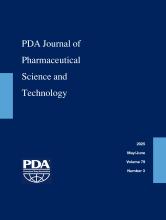Abstract
Container Closure Integrity (CCI) is one of the requirements for an aseptic or sterile packaging system. For vial-based systems, the capping process is a critical step in creating and ensuring an adequate seal with acceptable CCI. Closure Integrity Tests (CCIT) such as Dye Ingress test and Helium Leak rate test are two methods among many that, in the appropriate scenario, can provide the right methods to challenge this required attribute. The use of locked-in stopper compression (the compression under the crimp seal post-capping) enables correlation of these methods to CCI and seal quality. In fact, the overall acceptability of a seal can be evaluated using various quantitative and qualitative methods. Usually lost in these assessments is the existence of seal cosmetics as an essential additional seal quality attribute. Unacceptable cosmetic quality can have major impact on manufacturing (reduced batch output, high yield cost etc.) and user (perceived low quality and brand image, potential injury etc.) experiences. The opposite is also true that the aesthetics of a seal is impacted by the capping process. The acceptance criteria for aesthetics of a seal is subjective which makes the capping process even more complicated. Ultimately, this not only has an effect on commercial manufacturing efficiency, but also on container closure integrity. In this study, we present a simple methodology for package selection and evaluated multiple package configurations using locked-in stopper compression (through Residual Seal Force, RSF) measurements and seal aesthetics analyses. A semi-quantitative aesthetics scale was developed to enable the analysis performed. The integrity of the seals were analyzed using multiple Container Closure Integrity Test (CCIT) methods. We determined that component dimensions such as the seal lengths play a major role in obtaining proper seal aesthetics and integrity. This can ultimately enable the selection of robust packaging components with the ability to provide an adequate range or flexibility of manufacturing conditions without cosmetic defects. A failure to do this could result in high rejects during drug product visual inspection culminating in low batch yield and high costs or pose harm to patients if suitable container closure integrity is not achieved.
- Received November 1, 2018.
- Accepted May 15, 2019.
- Copyright © 2019, Parenteral Drug Association
PDA members receive access to all articles published in the current year and previous volume year. Institutional subscribers received access to all content. Log in below to receive access to this article if you are either of these.
If you are neither or you are a PDA member trying to access an article outside of your membership license, then you must purchase access to this article (below). If you do not have a username or password for JPST, you will be required to create an account prior to purchasing.
Full issue PDFs are for PDA members only.
Note to pda.org users
The PDA and PDA bookstore websites (www.pda.org and www.pda.org/bookstore) are separate websites from the PDA JPST website. When you first join PDA, your initial UserID and Password are sent to HighWirePress to create your PDA JPST account. Subsequent UserrID and Password changes required at the PDA websites will not pass on to PDA JPST and vice versa. If you forget your PDA JPST UserID and/or Password, you can request help to retrieve UserID and reset Password below.






